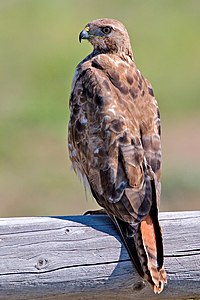
Photo from wikipedia
Monitoring demographic and genetic parameters of reintroduced populations of endangered species is essential for evaluating and informing conservation strategies to maximize the chances of a successful recovery. We applied noninvasive… Click to show full abstract
Monitoring demographic and genetic parameters of reintroduced populations of endangered species is essential for evaluating and informing conservation strategies to maximize the chances of a successful recovery. We applied noninvasive genetic monitoring using fecal DNA to evaluate demographic and genetic parameters as they relate to the recovery of the endangered Columbia Basin pygmy rabbit (Brachylagus idahoensis) in central Washington, United States, during the initial 3 years of a renewed reintroduction effort. We quantified post-release dispersal, apparent survival, and reproduction in the wild, and monitored the genetic diversity and composition of the released cohorts, wild surviving population, and breeding population held in large enclosures. During this study, we reintroduced 1,206 pygmy rabbits into the wild, and detected a total of 176 individuals living on or near the release area during surveys the following winters. Median dispersal distance of juveniles was 776 m, compared to 471 m for adults, and dispersal distances for juveniles decreased for rabbits released later in the release season. Survival of juveniles differed across years and was positively associated with release date, release weight (a surrogate for age), and heterozygosity. Survival of adults was similarly influenced by release day, with some evidence for a positive effect of heterozygosity. Only 14 wild-born individuals were detected during the study. Genetic monitoring was an effective way to evaluate the demographic and genetic status of the reintroduced population within a limited study area, to inform changes to the conservation strategy, and to generate a data set to address long-term research and recovery goals.
Journal Title: Journal of Mammalogy
Year Published: 2017
Link to full text (if available)
Share on Social Media: Sign Up to like & get
recommendations!